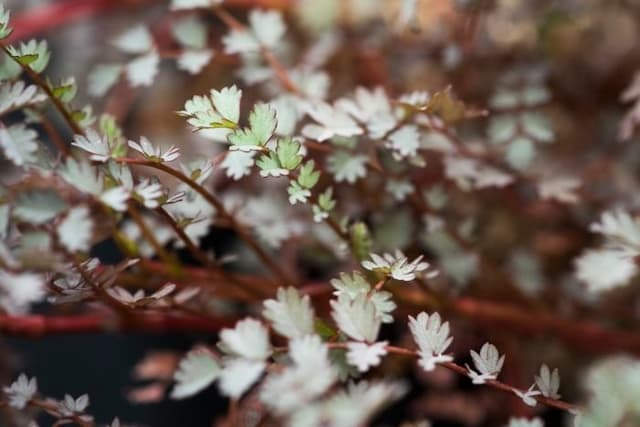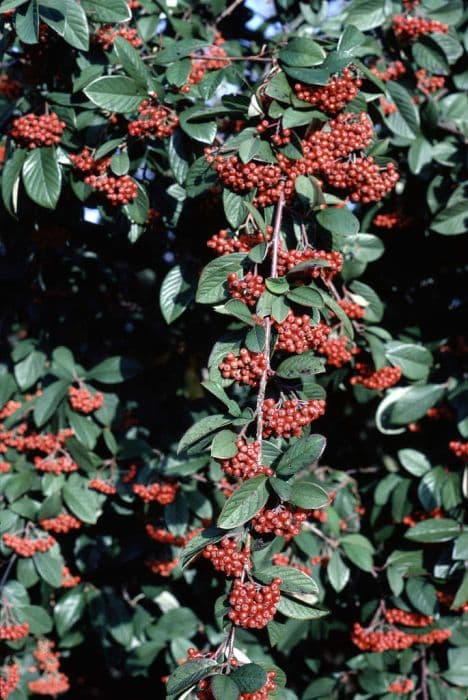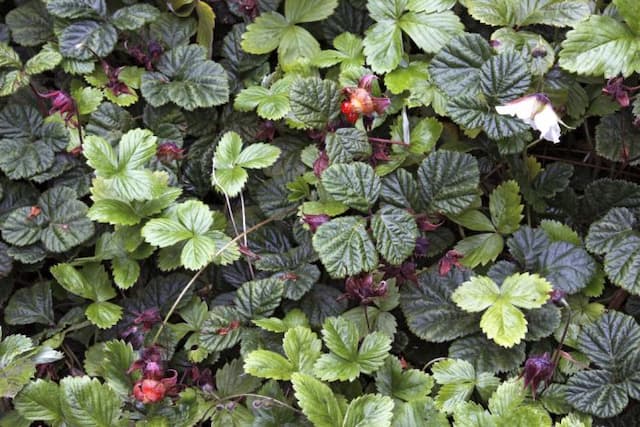Purple-flowering raspberry Rubus odoratus

ABOUT
The plant commonly known as purple-flowering raspberry bears broad, maple-like leaves that have a coarse, hairy texture and are often deeply lobed with jagged edges. The foliage tends to be bright green and can create a lush backdrop for the flowers. Blooming from late spring to early fall, this plant showcases clusters of showy, fragrant flowers. Each blossom possesses five large, light- to deep-pink petals forming a shallow cup or saucer shape, contrasting with the central yellowish-white stamens. After flowering, it produces soft, flat, red berries which resemble raspberries, but they are not as prickly and generally not considered as flavorful as their more popular relatives. These aggregates of small drupelets are edible, although they're often left for wildlife to enjoy rather than being harvested for human consumption. The overall impression of the plant is one of lushness and ornamental beauty, with a naturalistic feel that can attract pollinators like bees and butterflies to a garden.
About this plant
 Names
NamesFamily
Rosaceae.
Synonyms
Purple Flowering Raspberry, Thimbleberry, Flowering Raspberry, Virginia Raspberry.
Common names
Rubus odoratus var. villosus, Rubus vulgatus.
 Toxicity
ToxicityTo humans
The Rubus odoratus, commonly known as purple-flowering raspberry, is not considered toxic to humans. This plant, in fact, bears edible fruit that can be enjoyed raw or used in jellies and desserts. There are no well-documented cases of poisoning or toxic effects from consuming the fruit or other parts of the purple-flowering raspberry. However, as with any plant, individual allergic reactions can occur, and plant parts other than the fruit are not typically consumed.
To pets
The Rubus odoratus, also known as the purple-flowering raspberry, is generally not considered toxic to pets such as dogs and cats. The plant does produce fruit that is edible for humans, and it is typically not harmful to pets either. There is no significant evidence suggesting that ingestion of the purple-flowering raspberry by pets leads to poisoning or severe health consequences. However, it's always advisable to discourage pets from eating large quantities of any non-food plants, as they might cause gastrointestinal upset or an allergic reaction in sensitive individuals.
 Characteristics
CharacteristicsLife cycle
Perennials
Foliage type
Deciduous
Color of leaves
Green
Flower color
Pink
Height
3-9 feet (0.9-2.7 meters)
Spread
4-8 feet (1.2-2.4 meters)
Plant type
Shrub
Hardiness zones
4
Native area
North America
Benefits
 General Benefits
General Benefits- Ornamental Appeal: Rubus odoratus, commonly known as purple-flowering raspberry, has large, showy, pink to purple flowers that add aesthetic value to gardens and landscapes.
- Wildlife Attraction: The plant’s flowers attract pollinators such as bees and butterflies, while its fruit provides food for birds and other wildlife.
- Edible Fruit: The berries of Rubus odoratus are edible, though not as flavorful as some other raspberries, and can be used in jams and jellies.
- Shade Tolerance: This species can grow well in partial shade, making it a versatile choice for different garden conditions.
- Naturalization: Purple-flowering raspberry is good for naturalistic plantings and can help create a wild garden look or fill in woodland areas.
- Erosion Control: The plant's spreading habit and robust growth make it useful for stabilizing soil and preventing erosion on slopes or banks.
- Low Maintenance: Rubus odoratus is generally low maintenance, requiring minimal care once established in a suitable location.
- Seasonal Interest: With its attractive flowers in the spring and summer and its foliage that may turn colors in the fall, it offers multiple seasons of interest.
 Medical Properties
Medical Properties- Anti-inflammatory: Rubus odoratus has been traditionally used to reduce inflammation.
- Astringent: The plant's astringent properties are attributed to its tannin content, which can help with skin irritations and minor wounds.
- Diuretic: It has been claimed to promote the production of urine, aiding in the flushing out of toxins from the body.
- Expectorant: The plant's use as an expectorant suggests it may help in clearing respiratory tract by expelling phlegm.
- Antiseptic: The plant has been used for its antiseptic qualities, potentially helping to prevent infection in minor cuts and scrapes.
- Menstrual aid: There is traditional use of Rubus odoratus to alleviate symptoms associated with menstruation.
 Air-purifying Qualities
Air-purifying QualitiesThis plant is not specifically known for air purifying qualities.
 Other Uses
Other Uses- Rubus odoratus, commonly known as purple-flowered raspberry, can be used in landscape design for naturalizing areas, providing a rustic and wild look to gardens.
- Its attractive blooms serve as a food source for pollinators such as bees and butterflies, making it a beneficial plant for supporting local ecosystems.
- The branches of purple-flowered raspberry can be woven into baskets or other decorative items by skilled craftspeople.
- The large, maple-like leaves of the plant can be used as a natural green dye for fabrics and yarns, offering an eco-friendly dyeing option.
- Purple-flowered raspberry is occasionally used in perfumery for its subtle, rose-like fragrance, which can be extracted from its flowers.
- Its pulp can be incorporated into handmade papers, adding texture and visual interest to the final product.
- Culinary enthusiasts sometimes use the fruit to create unique sauces or glazes for meat dishes, providing a sweet and tart flavor.
- The fruit can also be fermented to produce a homemade wine with a distinctive raspberry flavor.
- In craft cocktails, the berries of purple-flowered raspberry are muddled to add a fresh, fruity component to mixed drinks.
- During the fall, its vibrant foliage adds aesthetic value to the garden, as the leaves change to striking shades of orange and red.
Interesting Facts
 Feng Shui
Feng ShuiThe Purple-flowering Raspberry is not used in Feng Shui practice.
 Zodiac Sign Compitability
Zodiac Sign CompitabilityThe Purple-flowering Raspberry is not used in astrology practice.
 Plant Symbolism
Plant Symbolism- Attraction: The Rubus odoratus, commonly known as Purple-flowering Raspberry, produces vibrant flowers that attract pollinators, symbolizing allure and magnetism.
- Protection: With its thorny canes, the Purple-flowering Raspberry represents safeguarding and boundary-setting.
- Sweetness: As the plant produces berries, it is often associated with the sweetness of life and enjoying simple pleasures.
- Survival and Adaptability: Able to grow in various conditions, the Purple-flowering Raspberry symbolizes resourcefulness and the ability to thrive in different situations.
 Water
WaterFor the purple-flowering raspberry, or Rubus odoratus, maintain consistently moist soil without letting it become waterlogged. In general, water the plant deeply once a week with about 1-1.5 gallons, adjusting for rainfall and temperature changes. During the growing season, increase the frequency to twice a week if the weather is particularly hot or dry. In winter, reduce watering to match the plant's reduced need as it goes into dormancy. Always check the top inch of soil for dryness before watering to ensure you're not overwatering.
 Light
LightThe purple-flowering raspberry thrives in partial shade to full sun. It's adaptable but prefers a spot that receives dappled sunlight throughout the day or direct sun in the morning with some afternoon shade. Avoid locations where the plant will be exposed to harsh, midday sun, which can be too intense, especially in hotter regions.
 Temperature
TemperatureThe purple-flowering raspberry can withstand a range of temperatures but grows best in conditions between 60 and 75 degrees Fahrenheit. It should not be exposed to temperatures below 20 degrees Fahrenheit, as this can damage or kill the plant. During periods of extreme heat, providing some afternoon shade can help protect it and keep temperatures around the ideal range.
 Pruning
PruningPrune the purple-flowering raspberry for shaping, to remove any dead or diseased wood, and to encourage fresh growth and flowering. The ideal time for pruning is in late winter or early spring before new growth starts. Annually remove older canes that have already fruited to make room for new canes. Thin out crowded areas to improve air circulation and maintain plant health.
 Cleaning
CleaningAs needed
 Soil
SoilPurple-flowering raspberry prefers moist, well-draining soil with a pH ranging from 6.0 to 7.0. A mix of loam, peat, and sand in equal parts is ideal to ensure good drainage while retaining sufficient moisture.
 Repotting
RepottingPurple-flowering raspberry does not typically require frequent repotting due to its nature as a shrubby plant. Repotting every 2 to 3 years, or when it outgrows its current container, is sufficient for this species.
 Humidity & Misting
Humidity & MistingPurple-flowering raspberry thrives in average humidity levels consistent with outdoor conditions. It does not require any special humidity considerations when grown indoors.
 Suitable locations
Suitable locationsIndoor
Ensure bright light, well-draining soil, and adequate watering for indoor growth.
Outdoor
Plant in well-drained soil, partial shade to full sun, and water regularly.
Hardiness zone
3-8 USDA
 Life cycle
Life cycleCommonly known as purple-flowering raspberry, Rubus odoratus starts its life cycle from seed germination, which typically occurs in spring under appropriate conditions of moisture and temperature. The seedlings develop into juvenile plants with a rosette of trifoliate leaves and gradually form a woody stem. As the plant matures, usually in its second year, it begins to produce distinctive large, lobed leaves and canes that can grow several feet tall. During late spring to summer, Rubus odoratus enters its flowering stage, creating clusters of fragrant, purple flowers which are pollinated by insects, leading to the formation of red raspberry-like fruits by late summer, though these are not as commonly consumed as those from other Rubus species. After fruiting, the plant enters a period of dormancy during the colder months. The life span of Rubus odoratus can extend several years due to its ability to propagate vegetatively through suckers, leading to new shoots and canes which contribute to its survival and spread.
 Propogation
PropogationPropogation time
Spring to Summer
The most popular method for propagating the Purple-flowering Raspberry, or Rubus odoratus, is through softwood cuttings. This typically occurs in late spring to early summer when new growth is mature enough yet still tender. To propagate by cuttings, one would cut a 4 to 6 inch (10 to 15 cm) piece of stem from a healthy parent plant, making sure that there are at least a few leaves attached. The lower leaves are removed, and the cut end is often dipped in rooting hormone powder to encourage root development. The cutting is then planted in a moist potting mix, ensuring that the leaf nodes where you removed the leaves are buried, as this is where roots will often form. The pot should be placed in a warm, bright area but out of direct sunlight, and kept consistently moist. With proper care, the cutting will develop roots and can be transplanted into the garden once it has established a sufficient root system.









